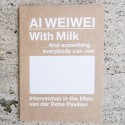





Intervention in the Mies van der Rohe Pavilion
Author: Xavier Costa (Editor)
Publisher: Fundació Mies van der Rohe & Actar Publishers
Size: 20 x 28 x 0,7 cms
Pages: 36
Illustrations: Color
Cover: Corrugated cardboard with staple binding
Publication date: 2010
ISBN: English 9788493690137
With Milk
___find something everybody can use
"Mies van der Rohe’s Barcelona Pavilion stood out beyond all doubt. Its concrete materials weightless, barely held down to the ground. Stone and glass are nothing new to architecture, but now they are lenses and mirrors in which to see an enlightened age. The pools, blank, along with other highly polished surfaces, a timeless gaze reflecting everything else around, the building, the sky and the trees. This is a place where only gods dwell.
Perhaps this view misinterprets Mies’ work; it left out the modern dream of equality, as well as architecture of living, the needs of every ordinary person. Speaking about design Mies frequently used expressions such as “general solution” and “common language”.
I approach Mies van der Rohe’s Barcelona Pavilion as a ready-made, the activities it experienced and the way it’s been seen. The building is not static, in fact; my intervention explores the metabolism of a living machine. Liquid is replaced because it is a part of the building that has always been replaced. In fact, the content of the two pools is replaced all the time, unnoticed to visitors. A pump re-circulates water in the large outdoor pool, while the smaller pool is drained every two weeks, the dark glass at the bottom is cleaned and the pool refilled.
Regular work is done to ensure that the monument appears unchanged, timeless; not forgetting that the entire building stands as a perfect reconstruction. In milk and coffee intervention, the under layer of this monument surfaces and persists in consciousness; it refuses to be flushed away. Upkeeping the condition of milk and coffee is the same as preserving a body, a demanding effort against light, air, warmth… anything encourages growth and change. What is vigour of geometry, clarity of assembly and enlightened optimism combined with ordinary everyday life? In its endeavour to correct mistakes of the past, Modernism might have made new mistakes. Today’s cultural attitude doesn’t mind mistakes; it sets out to move forward unafraid of making new ones."
Ai Weiwei
Ai Weiwei en el Pabellón Mies van der Rohe by Nihao Films